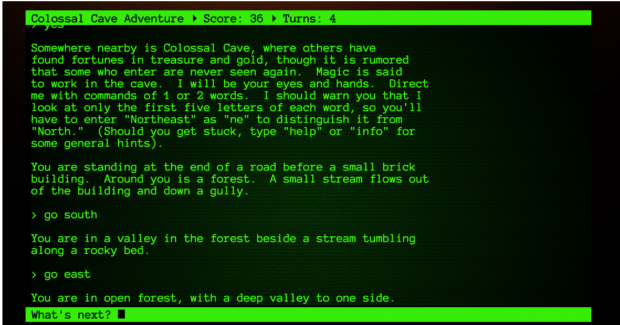Colossal Cave Adventure
The first work of interactive fiction was Colossal Cave Adventure. Its first iteration was developed in 1975-76 by Will Crowther, a Cambridge, Massachusetts-based programmer who was part of the team that developed ARPANET, the original network infrastructure on which the Internet is based (Montfort, 1997, p. 86), and subsequently expanded by Don Woods (1977). Crowther turned his programming skills towards a game about cave exploration after his divorce in order to entertain his children when they visited him (Nelson, 2001, p. 343). Crowther had been a spelunker in his past, helping to map a network of caverns in Kentucky (Jerz, 2007). He used that experience as the basis for the network of caves described in Adventure. The game itself provided a relatively simple experience of navigation and puzzle solving. Players attempted to retrieve objects from within the cave environments, and to win by completing their collection—a kind of textual geocaching.
Crowther originally developed the program for his own kids to play, but in 1977 he posted it on an ARPANET bulletin board, where others could download it and subsequently modify it. This is an important fact and compelling to consider in the light of the evolution of the field of electronic literature. Although commercial and institutional efforts were important for the development of both interactive fiction and hypertext as forms, the real expansion of the field took place after the widespread adoption of the World Wide Web, and the most important distribution channel for electronic literature has been the network, where authors often publish their own work and enable users to experience it online or download it for free.
Crowther himself described Adventure as fairly rudimentary, “just some rather simplistic logic and a small table of known words—of course backed up by some very clever thinking," (Jerz, 2007, p. 20) but he expressed delight that many of the people who played the game thought that there was some complex AI at work enabling players to interact conversationally with the program—an effect very similar to that described by Joseph Weizenbaum when users first interacted with the chatbot ELIZA (1966), seeking privacy for their interactions with a virtual psychologist who was after all only a simple program emulating the talk therapy technique of mirroring, responding to the interactor’s input with different linguistic formulations of the same text (Weizenbaum, 1976).
Crowther’s game set out many of the elements that would become standard components of interactive fiction. The original version of Adventure could recognize 193 words, and provided players with instructions to direct it with commands of 1 or 2 words (Jerz, 2007, p. 30). The essential activity of the game is moving through space and working out some basic puzzles. Crowther did not set out to simply replicate the experience of caving, but also introduced some magical and fantastic elements. The cave is populated with adversaries such as a dwarf, a dragon, and a snake.
The most popular version of Adventure is considered to be a co-authored work by Crowther and Don Woods. After Woods downloaded Adventure from APRANET and played it, he forked the code and expanded considerably upon the original work. While he kept Crowther’s “maze of twisty little passages all alike” he also included a “maze of twisty little passages, all different.” Woods added a number of significant elements to the game, such as a pirate who appears at random to steal the treasure the player has gathered, and objects with tracked states, and a water bottle that can not only be drunk from or emptied, as in the original game, but also refilled with water or oil, and inserted a number of new puzzles. Graham Nelson highlights Crowther and Woods’s distinctly different approaches, “one intent on recreating an experienced world, the other with a really neat puzzle which ought to fit somewhere” (Nelson, 2001, p. 345). As Jerz demonstrated by actually traversing the physical cave system that Crowther explored in Kentucky, the geography of the world originally conceived by Crowther was based fairly faithfully upon his caving experiences in the Bedquilt region of Colossal Cave, while Woods expanded upon the fantastical context of the game.
(Source: Electronic Literature by Scott Rettberg)
Research Collection that references this work:
Critical writing that references this work:
- 1 of 2
- next ›


